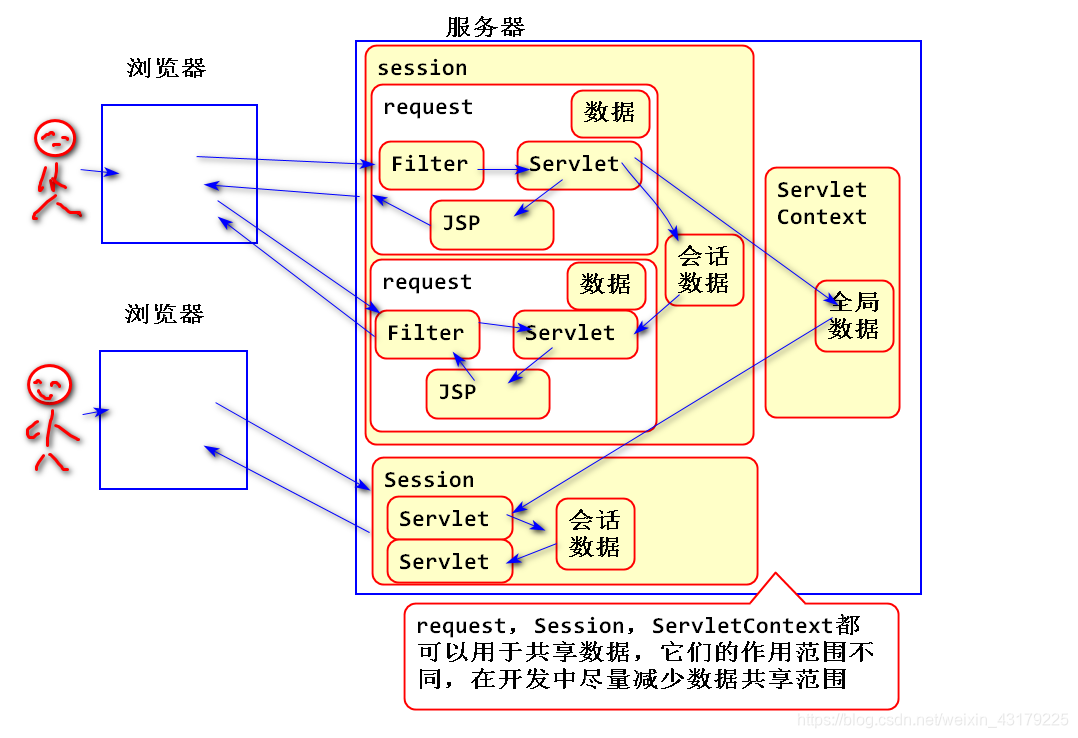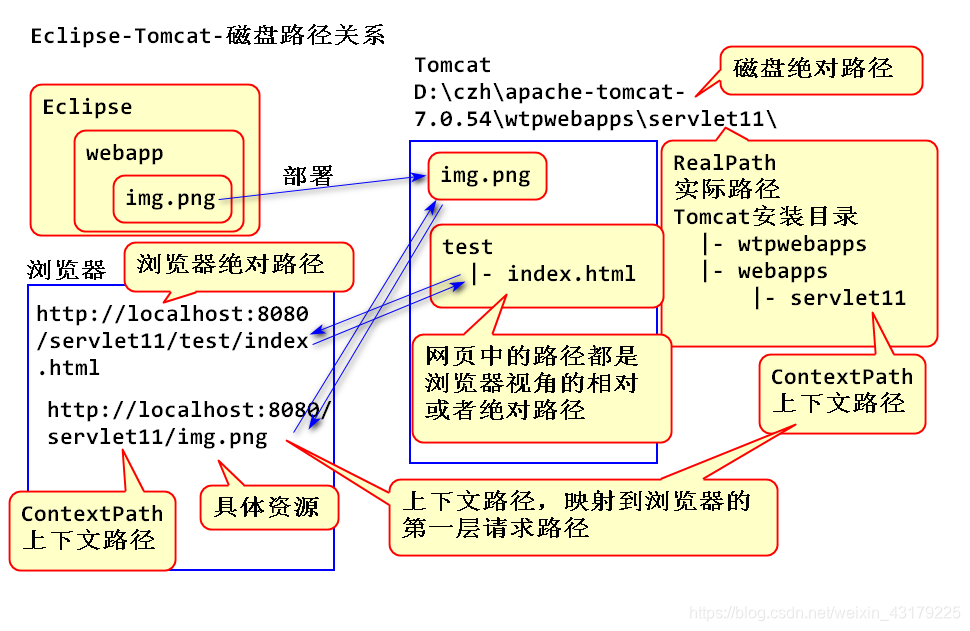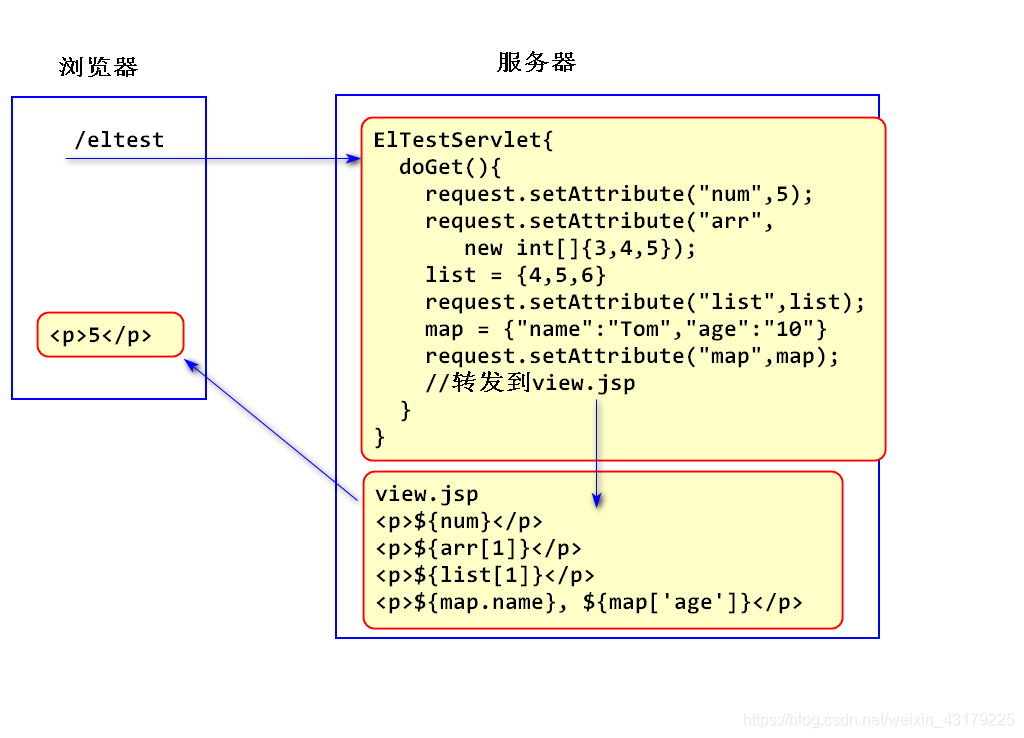Servlet/JSP
ServletContext
Context: 上下文,当前事物存在的前后环境场景。
ServletContext:当前Servlet存在的运行环境。代表Web容器。

1. 任何获取 ServletContext 的方法获取的对象都是同一个ServletContext对象的引用
1. 调用从 HttpServlet继承的方法获取ServletContext
ServletContext ctx1 = getServletContext();
2. 调用request对象getServletContext()方法获取ServletContext
ServletContext ctx2 = request.getServletContext();
2. 可以使用ServletContext提供的方法与当前Web容器进行通讯
1. ctx1.getServerInfo() 获取当前容器版本信息
2. ctx1.getRealPath() 获取当前程序的实际路径,硬盘物理位置
- 使用这个方法可以获取图片等资源的磁盘位置,进而使用IO API进行操作。
3. ctx1.getContextPath() 获取当前应用程序的上下文路径
- 用于拼接web绝对路径,解决路径问题。
3. ServletContext对象可以绑定共享当前应用的全局数据。
- setAttribute()
- getAttribute()
- removeAttribute()
- 建议在修改期间进行同步(加锁)处理
案例:显示Web容器相关信息:
/**
* 测试ServletContext
*/
public class DemoServlet extends HttpServlet {
private static final long serialVersionUID = 1L;
protected void doGet(HttpServletRequest request, HttpServletResponse response) throws ServletException, IOException {
//1. 调用从 HttpServlet继承的方法获取
// ServletContext
ServletContext ctx1 = getServletContext();
//2. 调用request对象getServletContext()方法
// 获取ServletContext
ServletContext ctx2 = request.getServletContext();
//3. ...
//“任何”方法获取的ServletContext都是同一个对象
//ServletContext 代表当前Servlet的运行容器
//显示当前Web容器的信息
System.out.println(ctx1.getServerInfo());
//重要:显示当前Web容器的实际路径(磁盘位置)
System.out.println(ctx1.getRealPath("/"));
//重要:显示当前Web程序的上下文路径(应用程序名)
System.out.println(ctx1.getContextPath());
response.setContentType(
"text/html;charset=UTF-8");
response.getWriter().print("OK");
}
}
<servlet-mapping>
<servlet-name>DemoServlet</servlet-name>
<url-pattern>/demo</url-pattern>
</servlet-mapping>
<servlet>
<description></description>
<display-name>SetValueServlet</display-name>
<servlet-name>SetValueServlet</servlet-name>
<servlet-class>web.SetValueServlet</servlet-class>
</servlet>
案例:利用ServletContext共享数据

代码:
/**
* 利用ServletContext共享数据
*/
public class SetValueServlet extends HttpServlet {
private static final long serialVersionUID = 1L;
protected void doGet(HttpServletRequest request, HttpServletResponse response) throws ServletException, IOException {
ServletContext ctx=getServletContext();
synchronized (ctx) {
ctx.setAttribute("test", "Hello World!");
}
response.setContentType(
"text/html; charset=UTF-8");
response.getWriter().print(
"添加数据到ServletContext");
}
}
/**
* 读取 ServletContext中的数据
*/
public class GetValueServlet extends HttpServlet {
private static final long serialVersionUID = 1L;
protected void doGet(HttpServletRequest request, HttpServletResponse response) throws ServletException, IOException {
ServletContext ctx = getServletContext();
String msg = null;
synchronized (ctx) {
msg = (String)ctx.getAttribute("test");
}
response.setContentType(
"text/html; charset=UTF-8");
response.getWriter().println("数据:"+msg);
}
}
<servlet>
<description></description>
<display-name>SetValueServlet</display-name>
<servlet-name>SetValueServlet</servlet-name>
<servlet-class>web.SetValueServlet</servlet-class>
</servlet>
<servlet-mapping>
<servlet-name>SetValueServlet</servlet-name>
<url-pattern>/set</url-pattern>
</servlet-mapping>
<servlet>
<description></description>
<display-name>GetValueServlet</display-name>
<servlet-name>GetValueServlet</servlet-name>
<servlet-class>web.GetValueServlet</servlet-class>
</servlet>
<servlet-mapping>
<servlet-name>GetValueServlet</servlet-name>
<url-pattern>/get</url-pattern>
</servlet-mapping>
数据共享范围 request session servletContext
Web编程时候,可以利用request session servletContext共享数据,称为共享范围(scope),在使用数据共享范围时候,尽量使用小范围。

关于路径问题

JSP
JSP: Java Server Page: Java 服务器端页面
1. 为何有JSP
1. HTML是静态网页,内容固定。适合内部不变的信息
2. Servlet可以出来动态内容,拼接HTML标签,书写繁琐。
3. Sun设计了JSP,采用类似于HTML的语法书写Servlet
2. JSP工作原理:
1. 将JSP文件先翻译为 .java 的Servlet源文件。
2. 将 .java 的Servlet源文件编译为 .class
3. 运行时候执行 .class 文件。
3. JSP优点:
1. 可以利用传统HTML编辑器编写JSP
2. Java自动完成翻译工作。减少了编程量。
4. JSP适合作为显示界面--“视图”,与Servlet搭配使用
1. Servlet负责数据计算,业务处理
2. JSP负责将计算结果和业务处理结果拼接为HTML,显示给用户。
JSP语法
JSP 中可以嵌入Java代码
- JSP脚本片段
- JSP表达式
- JSP声明元素
如上代码方式以及不建议使用了!建议使用JSTL、EL进行替代
JSTL/EL
概念: JSTL 标准标签库 和 EL 表达式语言
JSP中的Java代码丑陋,编写风格与HTML不同,容易出现异常,不方便处理异常。
JSTL出现的历史:
- SUN提供了自定义标签技术。与HTML语法类似。
- Apache 在自定义标签技术之上,提供了统一通用标签。
- Servlet2.5 标准以后将JSTL采纳为默认标准
JSTL就是为了替换 JSP 中的Java代码的!
EL 表达式语法
基本语法:
${表达式}
EL语法:
- 从JSP的4个Scope中查询数据,从小到大依次查询
- page pageContext 就是当前JSP页面内部
- request
- session
- application 就是 ServletContext 对象
- 使用 requestScope.list 或者 sessionScope.list 指定查找某个范围
- 访问查询到数据的内容
- 包装类型:直接输出
- 数组: 可以使用[index]获取元素
- 集合: 可以使用[index]获取元素, 可以使用[key]获取元素
- 对象: 可以使用[属性]获取元素,或者 .属性, 注意,属性需要有get、set方法
- 综合使用上述方法: users[1].name
- 将数据输出到页面
案例1:

代码:
/**
* 测试 EL 表达式
*/
public class ElTestServlet extends HttpServlet {
private static final long serialVersionUID = 1L;
protected void doGet(HttpServletRequest request, HttpServletResponse response) throws ServletException, IOException {
request.setAttribute("num", 10);
request.setAttribute("arr", new int[]{3,4,5});
List<Integer> list=new ArrayList<Integer>();
list.add(55);
list.add(66);
list.add(77);
request.setAttribute("list", list);
Map<String, String> map=
new HashMap<String, String>();
map.put("name","Tom");
map.put("age", "10");
request.setAttribute("map", map);
//转发到JSP页面,利用EL表达式显示数据
request.getRequestDispatcher("view.jsp")
.forward(request, response);
}
}
<%@ page language="java"
contentType="text/html; charset=UTF-8"
pageEncoding="UTF-8"%>
<!DOCTYPE html>
<html>
<head>
<meta charset="UTF-8">
<title>Insert title here</title>
</head>
<body>
<h1>EL表达式显示数据</h1>
<p>${num}</p>
<p>${arr[1]}</p>
<p>${list[1]}</p>
<p>${map.name}, ${map['age']}</p>
</body>
</html>
案例2:
/**
* Servlet implementation class ElTest2Servlet
*/
public class ElTest2Servlet extends HttpServlet {
private static final long serialVersionUID = 1L;
protected void doGet(HttpServletRequest request, HttpServletResponse response) throws ServletException, IOException {
Student student = new Student("Jerry", 5);
request.setAttribute("stu", student);
request.getSession()
.setAttribute("user", student);
List<Student> list=new ArrayList<Student>();
list.add(new Student("熊大",10));
list.add(new Student("熊二",10));
request.setAttribute("list", list);
//转发到view2.jsp,利用EL表达式显示数据
request.getRequestDispatcher("view2.jsp")
.forward(request, response);
}
}
<%@ page language="java"
contentType="text/html; charset=UTF-8"
pageEncoding="UTF-8"%>
<!DOCTYPE html>
<html>
<head>
<meta charset="UTF-8">
<title></title>
</head>
<body>
<h1>EL表达式显示对象数据</h1>
<p>数据为空:${num}</p>
<p>${stu.name}</p>
<p>${list[1].name}</p>
<p>读取Session中的数据:${user.name}</p>
</body>
</html>
JSTL 标准标签库
JSTL 是一组自定义标签组成的,需要导入解析标签的类文件。
<dependency>
<artifactId>jstl</artifactId>
<groupId>jstl</groupId>
<version>1.2</version>
</dependency>
在页面中使用 taglib 引入标签库
核心标签:
<%@ taglib prefix="c"
uri="http://java.sun.com/jsp/jstl/core"%>
格式化标签:
<%@ taglib prefix="fmt"
uri="http://java.sun.com/jsp/jstl/fmt"%>
JSTL 包含4个标签库
- 核心标签库 core,最常用,提供了用于替换 JSP中Java代码的标签
- c:if 单路分支
- c:choose 多路分支(双路)
- c:forEach 遍历
- 格式标签库 fmt,不常用
- 数字: 5660 -> RMB5,660.00
- 日期表格化: 2019-06-12
- XML 标签库 xml,不用了解
- SQL 标签库 sql,不用了解
Java 的标签库 JSTL、EL 是在服务器端执行的,用于拼接HTML页面。
案例1:
/**
* 演示JSTL的功能
*/
public class JstlTestServlet extends HttpServlet {
private static final long serialVersionUID = 1L;
@Override
protected void doGet(HttpServletRequest req, HttpServletResponse resp) throws ServletException, IOException {
req.setAttribute("num", 0);
Student stu = new Student("小明", 20);
req.setAttribute("user", stu);
req.getRequestDispatcher("view3.jsp")
.forward(req, resp);
}
}
<%@ page language="java"
contentType="text/html; charset=UTF-8"
pageEncoding="UTF-8"%>
<%@ taglib prefix="c"
uri="http://java.sun.com/jsp/jstl/core"%>
<!DOCTYPE html>
<html>
<head>
<meta charset="UTF-8">
<title>JSTL</title>
</head>
<body>
<h1>JSTL</h1>
<h2>单路分支</h2>
<c:if test="${num == 0}">
<p>num 的值是0</p>
</c:if>
<h2>多路分支、双路分支</h2>
<c:choose>
<c:when test="${user.age<12}">
<p>小明是小孩</p>
</c:when>
<c:when test="${user.age<22}">
<p>小明是小伙子</p>
</c:when>
<c:otherwise>
<p>小明是男人</p>
</c:otherwise>
</c:choose>
</body>
</html>
案例2:
/**
* for each 标签演示
* 迭代标签,用于遍历集合
*/
public class ForEachServlet extends HttpServlet {
private static final long serialVersionUID = 1L;
protected void doGet(HttpServletRequest request, HttpServletResponse response) throws ServletException, IOException {
List<Student> list=new ArrayList<Student>();
list.add(new Student("熊大",10));
list.add(new Student("熊二",10));
list.add(new Student("光头强",30));
list.add(new Student("Tom",20));
list.add(new Student("Andy",40));
list.add(new Student("传奇",35));
list.add(new Student("克晶",18));
request.setAttribute("users", list);
request.setAttribute("price", 3453.7);
request.setAttribute("today", new Date());
request.getRequestDispatcher("view4.jsp")
.forward(request, response);
}
}
<%@ page language="java"
contentType="text/html; charset=UTF-8"
pageEncoding="UTF-8"%>
<%@ taglib prefix="c"
uri="http://java.sun.com/jsp/jstl/core"%>
<%@ taglib prefix="fmt"
uri="http://java.sun.com/jsp/jstl/fmt" %>
<!DOCTYPE html>
<html>
<head>
<meta charset="UTF-8">
<title>JSTL</title>
</head>
<body>
<h1>JSTL 迭代标签</h1>
<!--
<ul>
<li>熊大,10岁,是小孩</li>
<li>熊二,10岁,是小孩</li>
<li>传奇,35岁,是爷们</li>
</ul>
-->
<ul>
<c:forEach items="${users}" var="user">
<li>${user.name}, ${user.age}, 是
<c:choose>
<c:when test="${user.age<12}">小孩</c:when>
<c:when test="${user.age<22}">小伙</c:when>
<c:otherwise>爷们</c:otherwise>
</c:choose>
</li>
</c:forEach>
</ul>
<h2>格式标签</h2>
<!-- format:格式化,Number:数字
1566023.4 -> RMB1,566,023.40
-->
<p>跳楼价:<fmt:formatNumber value="${price}"
pattern="RMB###,###,###.00"/></p>
<!-- 格式化日期 -->
<p>仅限今日:<fmt:formatDate value="${today}"
pattern="yyyy-MM-dd"/> </p>
</body>
</html>




 本文介绍了Servlet的ServletContext对象,包括其作用、特性及共享全局数据的方法。接着讨论了数据共享范围request、session和servletContext,并强调了使用小范围共享的推荐做法。此外,文章探讨了JSP的基本语法和JSTL/EL的引入,强调JSTL是为了替代JSP中的Java代码,提供更优的编写体验。EL表达式的语法和使用方法也在文中进行了说明,展示了如何从不同Scope中查询和输出数据。最后,提到了JSTL的核心标签库,如c:if、c:forEach等,及其在页面渲染中的作用。
本文介绍了Servlet的ServletContext对象,包括其作用、特性及共享全局数据的方法。接着讨论了数据共享范围request、session和servletContext,并强调了使用小范围共享的推荐做法。此外,文章探讨了JSP的基本语法和JSTL/EL的引入,强调JSTL是为了替代JSP中的Java代码,提供更优的编写体验。EL表达式的语法和使用方法也在文中进行了说明,展示了如何从不同Scope中查询和输出数据。最后,提到了JSTL的核心标签库,如c:if、c:forEach等,及其在页面渲染中的作用。
















 1万+
1万+

 被折叠的 条评论
为什么被折叠?
被折叠的 条评论
为什么被折叠?








